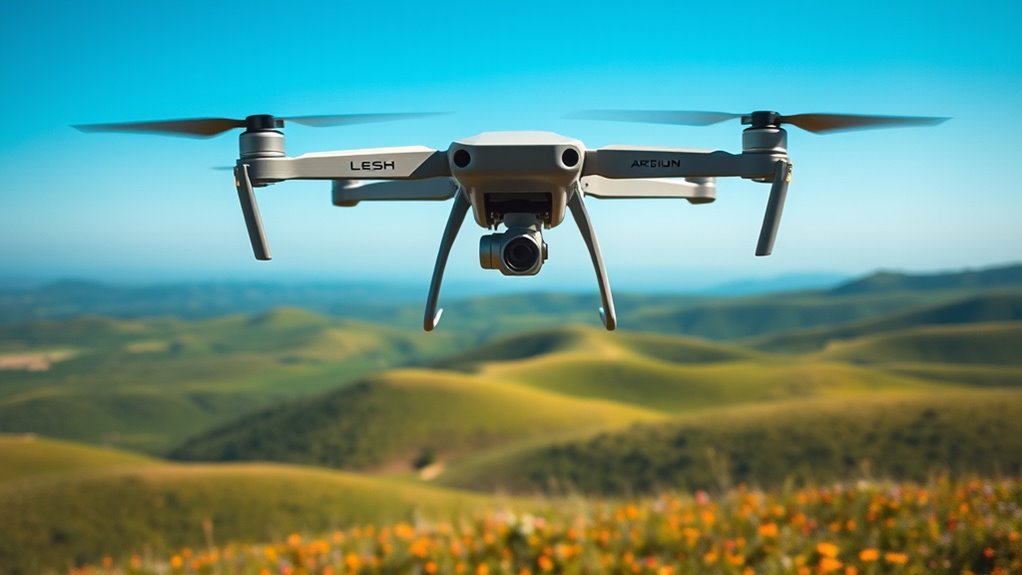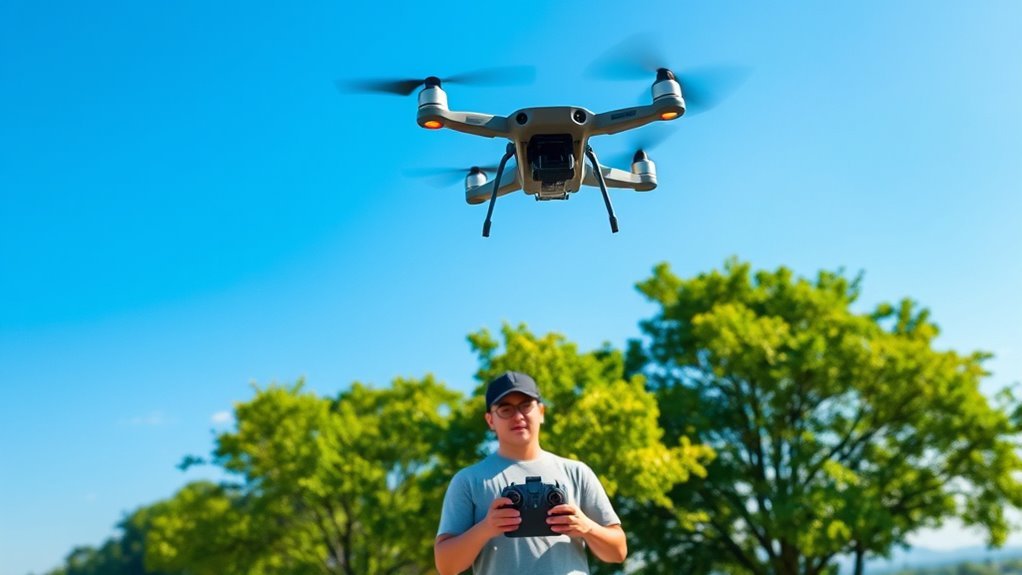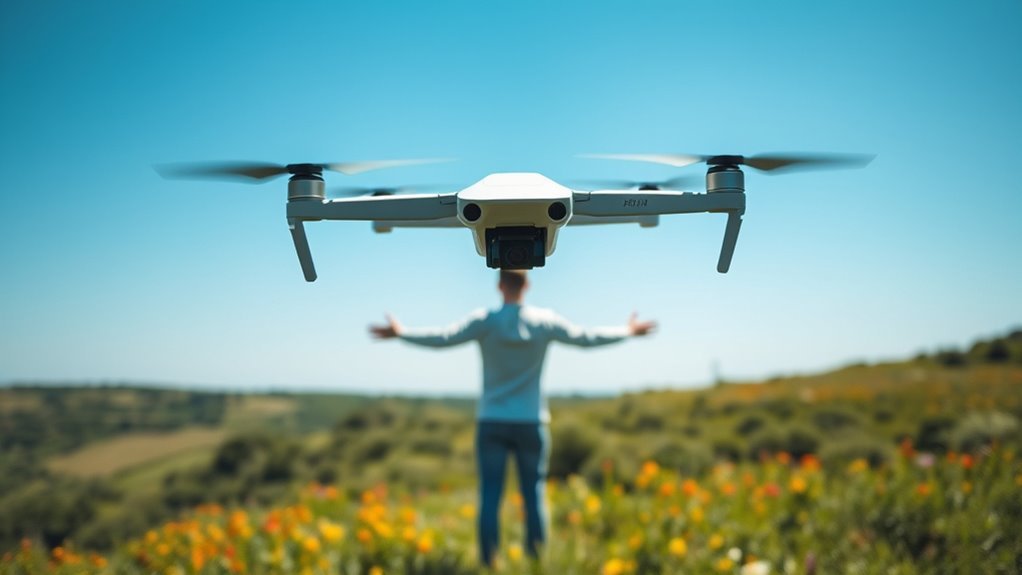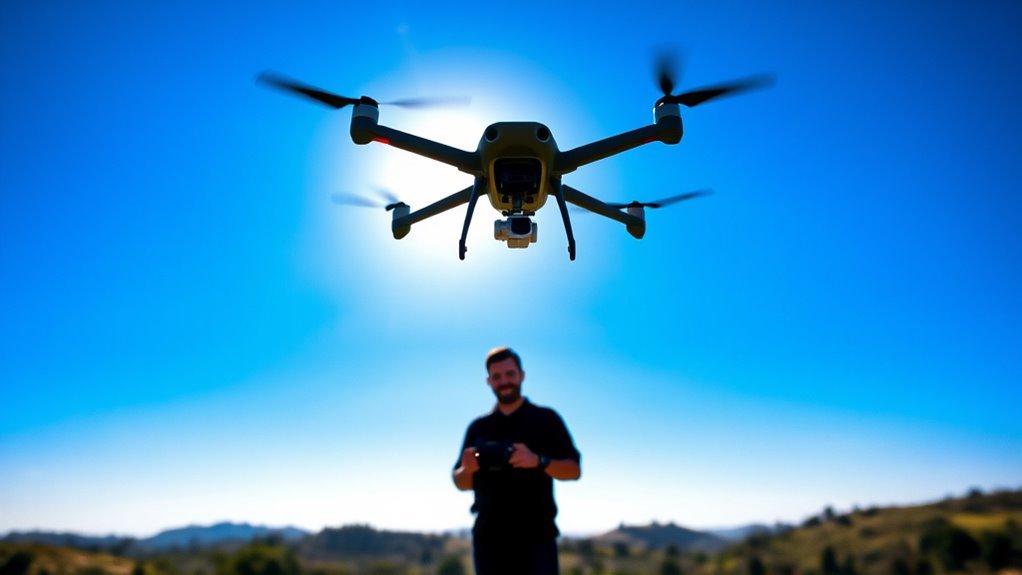Headless mode in drone control simplifies navigation by aligning the drone’s forward direction with your inputs. This means you don’t have to worry about the drone’s orientation; instead, you can focus on steering it intuitively. Orientation sensors and control algorithms manage the drone’s flight commands based on your viewpoint. While beneficial for beginners, be aware of its limitations, especially in complex environments. There’s much more to explore about this mode and its impact on your flying experience.
Understanding Headless Mode: A New Perspective on Drone Control

While traditional drone control relies heavily on the orientation of the aircraft, headless mode introduces a user-friendly approach that simplifies navigation. In this mode, the drone’s forward direction aligns with your control inputs, regardless of its actual orientation. This design empowers you, allowing for intuitive control without the need to constantly gauge the aircraft’s position. As a user, you gain enhanced drone navigation capabilities, freeing you from the complexities of traditional flight. Consequently, you can focus more on the experience and less on technical maneuvers. Headless mode embodies a shift toward user empowerment, making drone operation accessible to a broader audience. It transforms the flying experience, encouraging exploration and creativity in ways that traditional methods might restrict.
The Benefits of Headless Mode for Beginners

Headless mode greatly simplifies orientation control, allowing you to focus on maneuvering your drone without worrying about its facing direction. This feature not only reduces the cognitive load for beginners but also enhances the overall learning experience by enabling you to concentrate on mastering flight techniques. As a result, you can build confidence more quickly, making your entry into drone piloting smoother and more enjoyable.
Simplified Orientation Control
Understanding how to control a drone can be intimidating for newcomers, especially when trying to steer its orientation. Headless mode simplifies this process, allowing for a more enjoyable flying experience with user-friendly controls. Here are three key benefits:
- Intuitive Flying: You won’t need to worry about which way the drone’s front is facing; it responds based on your perspective.
- Easier Maneuvering: With simplified orientation, you can focus on steering rather than adjusting for directional changes.
- Boosted Confidence: By removing the complexity of orientation, you’ll build your skills faster and feel more empowered to explore.
Headless mode truly reveals a new level of freedom, making drone flying accessible to everyone, especially beginners.
Enhanced Learning Experience
For beginners, the learning curve of drone operation can be steep, but headless mode markedly enhances that experience. By eliminating the need to constantly adjust based on the drone’s orientation, headless mode allows you to focus on mastering flight controls. This technology promotes interactive training, enabling you to engage more deeply without the distraction of traditional directional complexities. Additionally, it complements immersive simulations, which provide realistic environments for practice. You can experiment with maneuvers and refine your skills without the fear of disorientation. As you gain confidence, headless mode empowers you to explore your drone’s capabilities freely, transforming the learning process into an enjoyable journey rather than a frustrating task. Embrace this innovation to accelerate your mastery of drone flight.
How Headless Mode Works: The Technology Behind It

When guiding a drone in headless mode, the control system simplifies directional input by decoupling the drone’s orientation from the pilot’s perspective. This innovation leverages advanced sensor technology and refined flight mechanics to enhance your control experience. Here’s how it works:
- Orientation Sensors: These detect the drone’s position and adjust commands based on your viewpoint, ensuring movement is intuitive.
- Control Algorithms: They translate your inputs into flight commands that disregard the drone’s current direction, allowing for seamless navigation.
- Feedback Loops: These systems continuously monitor the drone’s status, providing real-time adjustments to maintain stability and responsiveness.
Evaluating the Limitations of Headless Mode
While headless mode offers significant advantages in simplifying drone control, it’s vital to recognize its limitations. A limitations analysis reveals that this mode can lead to disorientation, particularly in complex environments. Users often report that the drone’s response can feel counterintuitive, especially when flying at varying distances or altitudes. This dissonance can result in a loss of situational awareness, making precise maneuvers challenging. Additionally, user feedback indicates that reliance on headless mode may hinder the development of important piloting skills, as it removes the necessity of understanding directional controls. Ultimately, while headless mode can enhance accessibility for novice pilots, it’s important to acknowledge these limitations to guarantee safe and effective drone operation.
Practical Tips for Using Headless Mode Effectively
Headless mode can be a useful tool for those maneuvering the complexities of drone operation, but maximizing its benefits requires a strategic approach. To effectively utilize headless mode, consider these practical tips:
Headless mode simplifies drone operation, but its advantages are best realized with a strategic and informed approach.
- Establish Clear Drone Positioning: Before activating headless mode, guarantee your drone is properly oriented. This will enhance your control and reduce disorientation.
- Maintain Flight Stability: Regularly monitor your drone’s altitude and position. Sudden movements can compromise stability, especially when in headless mode.
- Practice in Open Areas: Start in wide, unobstructed spaces to get comfortable with headless mode. Familiarity will boost your confidence and control.
The Future of Drone Navigation With Headless Mode
As drone technology evolves, the integration of headless mode is set to revolutionize navigation by simplifying control mechanisms. This advancement enhances user experience, allowing operators to focus more on the task at hand rather than orientation. Additionally, it enables versatile flying techniques, making drones more accessible to users of varying skill levels.
Simplified Control Mechanism
The emergence of headless mode in drone technology has revolutionized the way operators navigate and control their devices. This simplified control mechanism enhances your experience by removing the complexity tied to orientation. Here are three key benefits:
- Intuitive Directional Control: You can maneuver the drone based on your perspective, making it easier to execute complex maneuvers without worrying about the drone’s orientation.
- Reduced Learning Curve: Even beginners can quickly grasp drone navigation, allowing for a more accessible user interface.
- Increased Stability in Flight: Headless mode offers a more stable flying experience, minimizing the potential for misdirection during operation.
With these advancements, you’re empowered to explore the skies with confidence and freedom.
Enhanced User Experience
While maneuvering drones has traditionally required a keen understanding of orientation, the implementation of headless mode is set to greatly enhance user experience by streamlining control. This technology offers a user-friendly interface that eliminates the need for pilots to constantly adjust their perspective, allowing for more focus on the flight itself. With intuitive controls, you can command your drone’s movements without the confusion of directional orientation, enabling you to explore the skies with greater freedom. As you navigate, headless mode simplifies the learning curve, making it accessible for both novices and experienced pilots alike. Ultimately, this advancement promotes a more enjoyable and efficient flying experience, encouraging creativity and exploration in drone operations.
Versatile Flying Techniques
With headless mode revolutionizing drone navigation, pilots can now employ versatile flying techniques that were once challenging to master. This mode allows you to focus on the drone’s orientation rather than your position, enhancing aerial versatility. Here are three advanced maneuvers you can easily execute:
- Dynamic Turning: Adjust your flight direction without worrying about the drone’s front-facing position.
- Orbits: Fly in circular patterns around a point of interest, maintaining a consistent distance.
- Complex Patterns: Combine loops and rolls with ease, expanding your creative capabilities.
Frequently Asked Questions
Can Headless Mode Be Used in All Weather Conditions?
In the dance of flight, headless mode can face weather challenges. While it offers ease of control, wind and rain can disrupt flight stability. Always assess conditions before soaring to guarantee your drone’s graceful performance.
Does Headless Mode Affect Battery Life?
Headless mode can affect battery efficiency, as it may require more processing power to maintain orientation. This increase in demand could potentially reduce flight duration, depending on the drone’s design and power management capabilities.
Is Headless Mode Suitable for Advanced Drone Pilots?
Headless mode’s simplicity is like training wheels on a bike; while useful, it limits advanced techniques. For seasoned pilots, it often clashes with their preferences, as they seek the freedom to master precise control.
How Do Manufacturers Implement Headless Mode in Drones?
Manufacturers implement headless mode mechanics by aligning the drone’s orientation with the pilot’s input, enhancing user experience. This simplifies control, allowing you to focus on flying without worrying about the drone’s direction relative to its position.
Can Headless Mode Be Disabled During Flight?
Imagine steering a ship in a vast ocean; when you engage headless mode, you navigate freely. However, you can disable headless mode mid-flight, enhancing flight safety while reclaiming precise control over your drone’s orientation.

